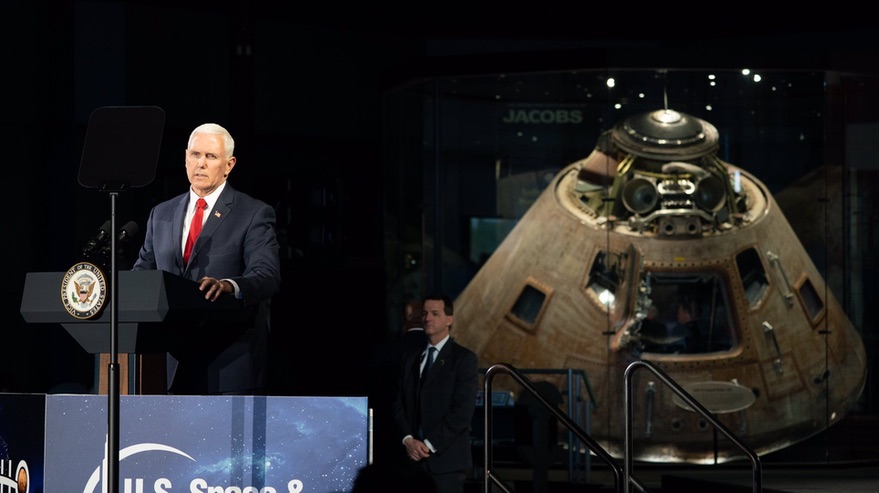
Updated 8:00 p.m. Eastern.
WASHINGTON — Vice President Mike Pence directed NASA to return humans to the surface of the moon by 2024, a dramatic acceleration of the agency’s human space exploration plans but a directive accompanied by few technical or fiscal details.
Pence, speaking at a meeting of the National Space Council March 26 in Huntsville, Alabama, said a new sense of urgency was needed in NASA’s plans given delays in ongoing programs like the Space Launch System and concerns about rising international competition.
“At the direction of the President of the United States, it is the stated policy of this administration and the United States of America to return American astronauts to the moon within the next five years,” Pence said. “To be clear: the first woman and the next man on the moon will both be American astronauts, launched by American rockets from American soil.”
Pence went so far as to direct where that landing will take place. “To reach the moon in the next five years we must select our destinations now,” he said. “NASA already knows that the lunar south pole holds great scientific, economic and strategic value, but now it’s time to commit to go there.”
That schedule would require a major acceleration of many elements of NASA’s plans, which previously called for landing humans on the moon by 2028. Among them is the SLS, the heavy-lift rocket whose continued delays led NASA to consider shifting the next uncrewed test flight of the Orion spacecraft to commercial vehicles.
That option now appears to be off the table. “I did open up the window to having commercial opportunities to launching the Orion crew capsule around the moon,” NASA Administrator Jim Bridenstine said. “There is an opportunity there in the future. I will also tell you that, if we want to achieve 2024, we have to have SLS. We have to accelerate its agenda.”
Bridenstine confirmed that in a NASA statement issued later March 26. “While some of these alternative vehicles could work, none was capable of achieving our goals to orbit around the Moon for Exploration Mission-1 within our timeline and on budget,” he said. “The results of this two-week study reaffirmed our commitment to the SLS.”
Bridenstine also endorsed continued development of the Exploration Upper Stage (EUS), which the administration’s budget request, released just 15 days ago, indefinitely deferred. “We’re going to need an Exploration Upper Stage, and we’re going to need that probably early: by EM-3, the third launch of the Space Launch System.”
While Bridenstine said he was confident that the first SLS launch, which was in danger of slipping to 2021, could take place in 2020, Pence offered a warning that appeared to be directed at Boeing, the prime contractor for the SLS core stage. “We’re committed to Marshall [Space Flight Center],” he said. “But to be clear, we’re not committed to any one contractor. If our current contractors can’t meet this objective, then we’ll find ones who will.”
“If commercial rockets are the only way to get American astronauts to the moon in the next five years, then commercial rockets it will be,” Pence added. “Urgency must be our watchword.”
Pence also appeared open to other alternative approaches. “The president has directed NASA and Administrator Jim Bridenstine to accomplish this goal by any means necessary,” he said. “We must focus on the mission over the means. You must consider every available option and platform to meet our goals.”
Pence cited as a reason for this new urgency competition from Russia and China, although neither country has formally committed to plans to land humans on the moon by the mid-2020s. “We’re also racing against our worst enemy, complacency,” he said, citing as an example the launch of Sputnik in 1957 that shocked the United States.
The vice president’s call to action was accompanied by few details, including how the program will be accelerated and at what cost. The council unanimously approved a set of recommendations about those plans at the end of the two-and-a-half-hour meeting with no debate, but the contents of those recommendations were not immediately disclosed. NASA also didn’t release additional details about its plans, although Bridenstine’s comments at the hearing suggested they still included development of a lunar Gateway that would enable access to the lunar poles.
Bridenstine said in the statement that, to implement this as-yet-undefined plan, NASA will form a new mission directorate “to focus on the formulation and execution of exploration development activities” called the Moon to Mars Mission Directorate. The agency didn’t explain how the new directorate would differ from the Human Exploration and Operations Mission Directorate, currently charged with implementing NASA exploration plans.
“You have given us a charge today and it is right on time,” Bridenstine told Pence. “NASA is going to do everything in its power to meet that vision, meet that deadline.”
Related
ncG1vNJzZmiroJawprrEsKpnm5%2BifLGxzZycZpuRobm0ecWoqWagpaKur3nRnquuqp5iwbB506GcZqWfpLturthmaWlqZGQ%3D